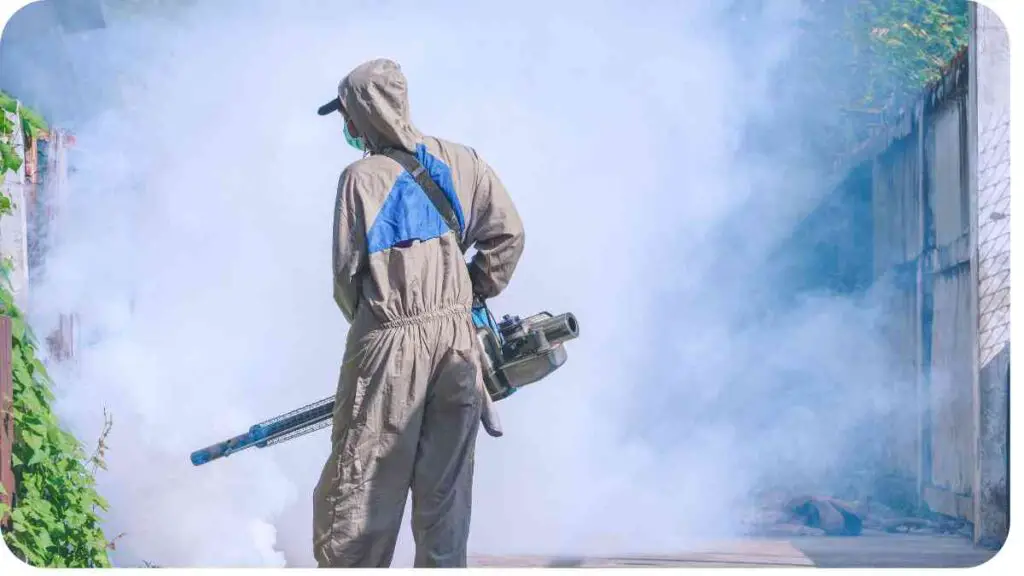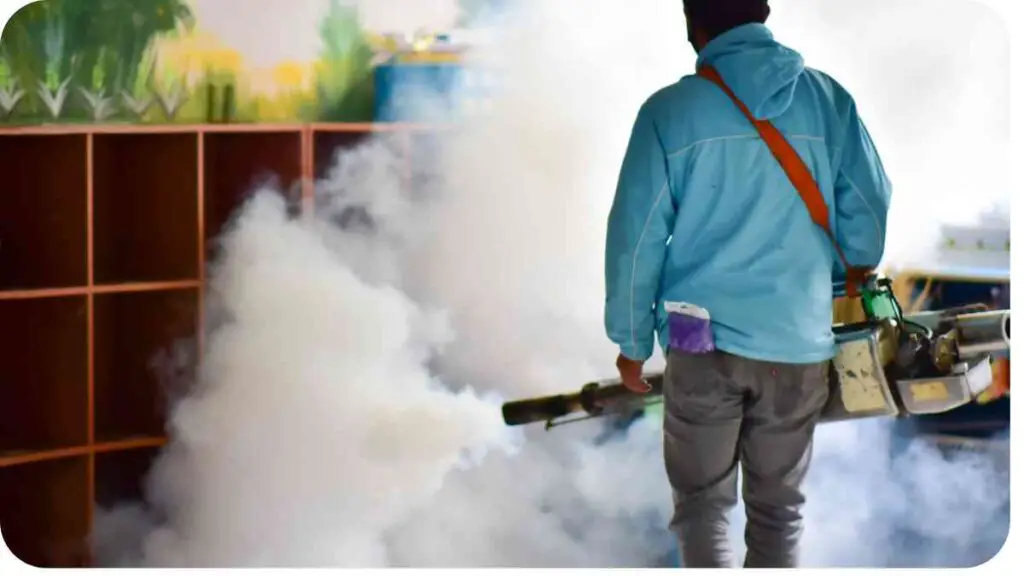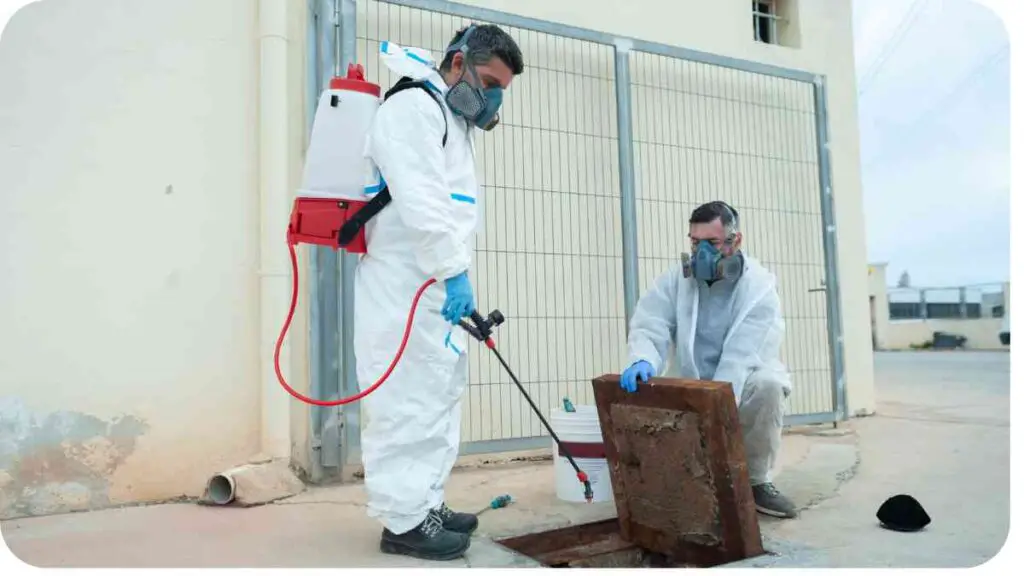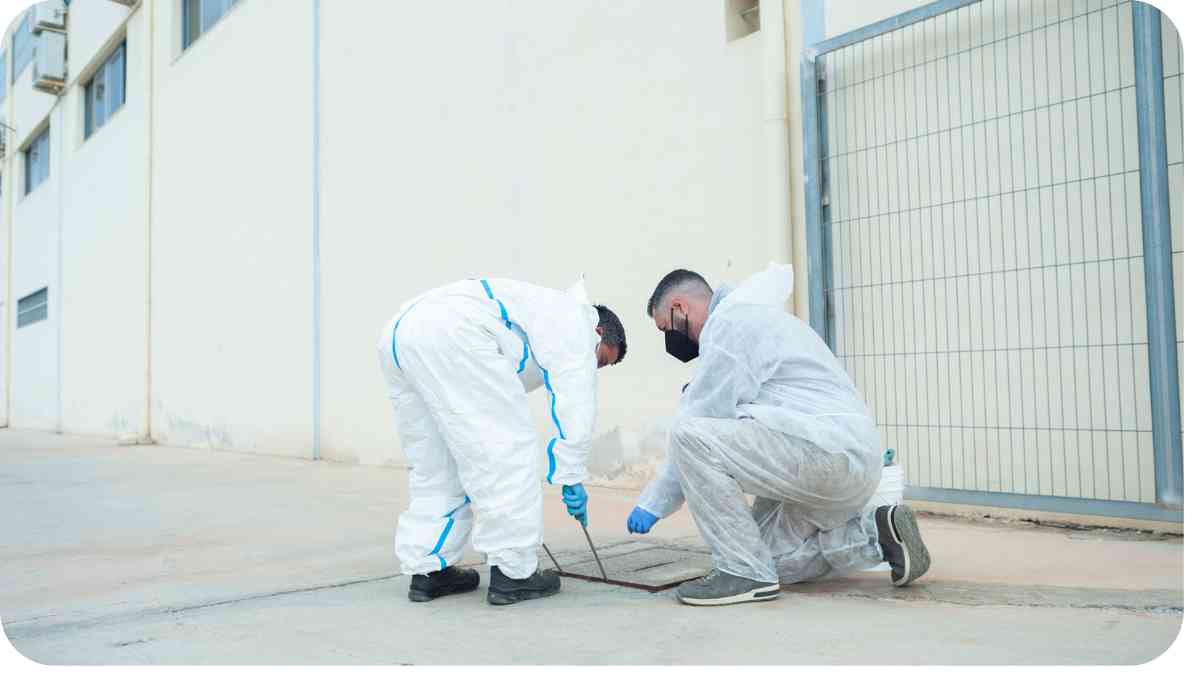Termite infestations can be a nightmare for homeowners, often requiring tenting or fumigation to effectively eliminate the pests. But how long does a tent stay on for fumigation?
In this comprehensive guide, we’ll walk you through the entire process of preparing for and undergoing termite fumigation, including how long the tent stays on and what to expect before, during, and after the process.
| Takeaways |
|---|
| Termite fumigation typically lasts for three days, including tenting, treatment, and aeration. |
| Proper preparation before fumigation is essential, including removing living things, sealing food and medication, and ensuring outdoor clearance. |
| Homeowners should follow safety guidelines during fumigation, including temporary relocation of pets, plants, and people. |
| Termite fumigation may cause minimal damage to roofing and landscaping, but precautions can be taken to minimize risks. |
| Once the fumigation process is complete and the structure is cleared, homeowners can safely return home. |
2. Before Fumigation

Removing Living Things
Before fumigation, it’s essential to remove all living things from your home, including people, pets, and plants. Fish and birds should also be relocated temporarily. Plants can be placed in the yard, but ensure they are kept at least one foot away from the perimeter of the house to avoid exposure to the fumigant.
Selecting the ideal grow tent enhances indoor gardening experiences, providing controlled environments for optimal plant growth and yield.” comprehensive guide for indoor gardeners
Table 1: Items to Remove Before Fumigation
| Items | Action Required |
|---|---|
| People | Temporarily vacate the premises |
| Pets | Temporarily relocate to a safe location |
| Plants | Move to the yard, keeping away from the house |
| Fish and Birds | Relocate temporarily |
Food & Medicine Storage
During fumigation, all food, feed, and medicine not factory sealed in glass or metal containers must be properly sealed in Nylofume bags. This ensures that these items remain safe from contamination by the fumigant. Your termite company will typically provide these bags and instruct you on how to seal them effectively.
Table 2: Guidelines for Food & Medicine Storage
| Items | Storage Instructions |
|---|---|
| Food, Feed, Medicine | Seal in Nylofume bags |
| Refrigerated Items | Bagged accordingly, including items in the freezer |
| Factory Sealed Items | Can remain in the house without bagging |
Wine & Spirits
Sealed items such as wine and spirits that are factory sealed in glass or metal containers can usually remain in the house without being bagged. However, it’s essential to ensure that seals have not been tampered with. Bottles with cork seals should be laid horizontally, while others can remain upright.
Table 3: Guidelines for Wine & Spirits
| Items | Storage Instructions |
|---|---|
| Factory Sealed Wine | Can remain in the house without bagging |
| Bottles with Cork Seals | Lay horizontally |
| Bottles with Other Seals | Can remain upright |
Bedding
It’s crucial to remove plastic mattress covers and baby mattresses enveloped with plastic before fumigation. Failure to do so may impede the proper aeration of the fumigant, reducing its effectiveness in eliminating termites.
Renting a 30×60 tent offers ample space for large gatherings and events, ensuring comfort and shelter for all attendees.” How much to rent a 30×60 tent?
Table 4: Bedding Preparation
| Items | Action Required |
|---|---|
| Plastic Mattress Covers | Remove before fumigation |
| Baby Mattresses | Remove if enveloped with plastic |
3. Outdoors Preparation
Exterior Clearance
Before fumigation, ensure there is a minimum of one-foot clearance around the perimeter of the building. This involves cutting back trees, bushes, vines, and other plants to create sufficient space for the tenting process. Additionally, decorative gravel or bark should be moved away from the structure.
Table 5: Exterior Clearance Guidelines
| Items | Clearance Requirements |
|---|---|
| Trees, Bushes, Vines | Cut back to create one-foot clearance |
| Decorative Gravel | Move away from the structure |
| Other Plants | Maintain one-foot clearance from the perimeter |
Neighbor Communication
In some cases, you may need to communicate with your neighbors before fumigating your structure. This could involve obtaining their approval if their plants are near your building or if access to their yard is necessary. Ensuring a good relationship with your neighbors can help facilitate the fumigation process smoothly.
Table 6: Neighbor Communication
| Situation | Action Required |
|---|---|
| Proximity of Neighbor’s Plants | Obtain approval if necessary |
| Access to Neighbor’s Yard | Communicate and coordinate accordingly |
Roof Damage
It’s important to understand that walking on the roof during fumigation may damage certain roofing materials. Homeowners often opt to pay for tile repair services to address any damage incurred during the process.
Table 7: Roof Damage Considerations
| Roofing Material | Potential Damage |
|---|---|
| Aged Wood Shingles | Likely to be damaged during fumigation |
| Old Shake | Prone to damage from walking |
| Old Composition | May incur damage |
| New or Old Tile | Damage possible |
| Aluminum or Specialty Roofs | Considerations for damage |
Security Measures
While break-ins during fumigation are rare, it’s important to take precautions to protect your home. This may include removing valuables, informing neighbors, and considering hiring a security service if you have concerns about vandalism or theft.
Firework tents provide temporary setups for seasonal businesses, attracting customers with vibrant displays and festive merchandise.” How long do firework tents stay open?
Table 8: Security Measures
| Security Measure | Action Required |
|---|---|
| Removing Valuables | Secure valuable items |
| Informing Neighbors | Request assistance and vigilance |
| Hiring a Security Service | Consider for added protection |
Stay tuned for the next part of the article, where we’ll discuss what happens during and after the fumigation process, as well as important reminders to keep in mind throughout the procedure.
4. During Fumigation

Three-Day Process
Termite fumigation typically follows a three-day process. On the first day, the tent is erected over the home and carefully sealed to prevent the fumigant from escaping. Warning signs are posted on the exterior of the tent to alert passersby. The structure is then filled with the fumigant gas.
Table 9: Three-Day Fumigation Process
| Day | Activities |
|---|---|
| Day 1 | Tenting and sealing of the structure, gas filling |
| Day 2 | Gas concentration measurement, aeration preparation |
| Day 3 | Tent removal, structure clearance for re-entry |
No Reentry Policy
During fumigation, it’s crucial to adhere to the no reentry policy. At no point during the process may homeowners, occupants, or pets return to the premises until the home has been cleared for reentry. This policy ensures the safety of individuals and pets by minimizing exposure to the fumigant gas.
Tenting tables and chairs for events simplifies setup and organization, ensuring a cohesive and inviting atmosphere for guests.” How much to tent tables and chairs?
5. After Fumigation
Gas Shut Off & Restoration
Before fumigation, the gas supply to the home must be turned off. The fumigation company will coordinate with the local gas company to arrange for the shut-off. Homeowners or occupants are responsible for contacting the gas company to turn the gas back on and relight all appliances once the fumigation process is complete.
Table 10: Gas Shut Off & Restoration Process
| Activity | Responsibility |
|---|---|
| Gas Shut Off | Coordinated by the fumigation company |
| Gas Restoration | Homeowners or occupants must contact the gas company |
Moving Back In
Once the home has been cleared for reentry, homeowners can confidently move back in. Food items can be safely unbagged and used, plants and pets can return indoors, and mattress covers can be put back in place. It’s essential to follow the guidelines provided by the fumigation company to ensure a smooth transition back into the home.
Table 11: Moving Back In Checklist
| Activity | Action Required |
|---|---|
| Unbagging Food Items | Verify clearance for safe consumption |
| Bringing Plants and Pets Indoors | Ensure safety guidelines are followed |
| Replacing Mattress Covers | Restore bedding to original condition |
6. Important Considerations

California Law Requirements
California law mandates specific requirements for termite fumigation to ensure safety and compliance. One such requirement is the need to open at least one operational window in each room, with a minimum opening of three inches. For structures with multiple floors, only the windows on the top floor are opened, while first-floor windows remain locked.
Renting a 20×30 tent accommodates medium-sized gatherings and events, offering versatility and practicality for various occasions and venues.” How much does it cost to rent a 20×30 tent?
Table 12: California Law Requirements
| Requirement | Description |
|---|---|
| Window Opening Mandate | At least one operational window per room |
| Minimum Opening Size | Three inches |
| Multi-Floor Structures | Top floor windows opened, first-floor locked |
Industry-Wide Waivers
In addition to complying with California law, homeowners may need to sign industry-wide waivers related to foliage, burglary, and roof damage. These waivers acknowledge potential risks associated with the fumigation process and help protect both homeowners and termite control companies from liability.
Table 13: Industry-Wide Waivers
| Waiver Type | Description |
|---|---|
| Foliage Waiver | Acknowledgement of potential landscaping damage |
| Burglary Waiver | Disclaimer regarding break-ins during fumigation |
| Roof Damage Waiver | Understanding of potential roof material damage |
Security Considerations
While termite fumigation is generally a safe process, homeowners should take precautions to safeguard their property during the procedure. Although break-ins during fumigation are rare, the risk may increase during economic downturns. It’s advisable to notify local authorities, secure valuables, and consider hiring a security service for added protection.
Table 14: Security Considerations
| Security Measure | Action Required |
|---|---|
| Notification to Authorities | Inform local police department |
| Valuables Protection | Secure money, jewelry, and important documents |
| Hiring Security Service | Consider professional security monitoring |
Access Requirements
To ensure the effectiveness of the fumigation process, termite control companies require access to all areas of the house. This includes unlocking and opening all doors, including safes and locked filing cabinets. Additionally, any connected buildings must also be vacated to prevent gas transmission between structures.
Table 15: Access Requirements
| Access Requirement | Action Required |
|---|---|
| Unlocking and Opening Doors | Provide access to all areas of the house |
| Vacating Connected Buildings | Ensure all connected structures are also vacated |
Conclusion
Termite fumigation is a comprehensive solution for eradicating severe termite infestations and protecting your home from further damage. While the process may seem daunting, proper preparation and understanding of the steps involved can help homeowners navigate it smoothly.
By following the guidelines outlined in this article, homeowners can ensure their safety, protect their property, and maximize the effectiveness of the fumigation treatment. From preparing the indoors and outdoors to complying with legal requirements and security measures, thorough planning is essential for a successful fumigation experience.
Remember, termite fumigation is not just about exterminating pests it’s about safeguarding your investment and providing peace of mind for years to come. By partnering with a reputable termite control company and adhering to industry best practices, homeowners can enjoy a termite-free environment and a home that remains structurally sound for generations.
If you’re facing a termite infestation or considering fumigation as a preventive measure, don’t hesitate to reach out to experienced professionals for guidance and assistance. With the right support and preparation, you can protect your home and family from the devastating effects of termites.
Further Reading
- Your Questions About Tent Fumigation Answered: This comprehensive guide addresses common queries homeowners have about tent fumigation, providing valuable insights into the process and what to expect.
- Termite Fumigation Process by Hi-Tech Termite Control: Learn about the termite fumigation process from a trusted termite control company, including detailed steps and important considerations for homeowners.
- Termite Fumigation Tenting: How It Works and How to Prepare Your Home: This blog post explains the ins and outs of termite fumigation tenting, offering practical tips for preparing your home and ensuring a successful treatment.
FAQs
How long does termite fumigation take?
Termite fumigation typically takes about three days to complete. The first day involves tenting the structure and filling it with fumigant gas. On the second day, the gas levels are monitored to ensure adequate treatment. Finally, on the third day, the tent is removed, and the home is aerated to allow the gas to dissipate.
Is termite fumigation safe for pets and plants?
While termite fumigation is generally safe when conducted by professionals following industry standards, it’s crucial to remove pets, plants, and all living things from the home during the process. Proper precautions are taken to ensure the safety of occupants, but temporary relocation is necessary to avoid exposure to the fumigant gas.
What preparations are required before termite fumigation?
Before termite fumigation, homeowners must remove all living things, including people, pets, and plants, from the home. Additionally, food and medication must be properly stored or sealed in special bags. Outdoor clearance around the perimeter of the building is also necessary to ensure proper tenting and treatment.
Will termite fumigation damage my roof or landscaping?
Termite fumigation may cause minimal damage to roofing materials and landscaping features, depending on their age and condition. Homeowners should be aware that some roofing materials may be susceptible to damage during the tenting process, and precautions should be taken to minimize any potential risks.
How soon can I return home after termite fumigation?
Once the termite fumigation process is complete, homeowners can typically return home after the structure has been cleared for re-entry. This usually occurs on the third day, once the fumigant gas has dissipated and it is safe to occupy the premises.

I am Hellen James, a professional handywoman with expertise in improving home and garden spaces by using pergolas, gazebos, and tents.


